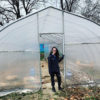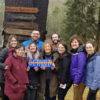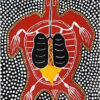Today is a fast day on the Jewish calendar, known as Shiva Assar B’Tammuz. The Mishnah (a compendium of Jewish oral traditions compiled in the third century) provides five tragedies that happened on this day in Jewish history: It was on this day that Moshe broke the two tablets; the day the tamid, or daily, animal offering was suspended; Jerusalem’s city walls were breached during the Roman siege; a man called Apostumos burned a Torah scroll; and an idol was erected in the Temple. The second “tragedy” – the cessation of the tamid animal sacrifice – is sitting with me this year more than ever as I complete my first year working at Hazon. As I dedicate more and more of my life to asking people to think carefully about the animal products they consume, it’s hard to feel terribly sad commemorating the inability to sacrifice an animal, to see the cessation of animal sacrifice as a tragedy. The name of this particular sacrifice – Tamid – is an important one. The word tamid in Hebrew can mean “forever”, “constantly”, or “routine.” The tamid offering was the mundane sacrifice, the routine one, the one that happened twice a day, every […]
Author Archive | Hazon

Hazon Detroit: Time to Grow
Dear Friends, I was present once, when a teacher told a full room, “In the years ahead, we will be called to be both the hospice caretakers of the old world, the old structures, and midwives of the new one.” It has stuck with me deeply ever since, as I’ve attuned my senses to a crossfade of sorts, watching the volume of an old way being turned down as the volume of a new song increases. With Passover just a few short days away, perhaps we could think of this crossfade like the mythic Israelites leaving Egypt, escaping the cacophony of slavery while cranking up the volume on liberation. At the crux of that crossfade is the 10th plague, when God vows to kill all Egyptian firstborn (Exodus 12:12). This of course, leads directly to the Israelite exodus across the sea. But this is not the whole story. In that same breath, God also promises to bring judgment on the false gods of Egypt (12:12). According to the midrash (Exodus Rabbah 16:3), the true and lasting liberation comes not only from the physical leaving of Egypt, but from the Israelites’ emphatic refusal to worship the idols of Egyptian rule. Yes, […]

Freedom You Have Not Yet Known: The Energy of the Month of Nissan
By Rabbi Ora Weiss The glorious energy of the month of Nissan is a breath of fresh air, a time of birth, of new starts, a spring-time for the spirit and soul. The invitation of this month, which begins this year on March 26 of the Gregorian calendar, has been called “the first of months of the year for you” (Exodus 12:2). Ramban, the medieval scholar and kabbalist, explains that although Nissan is not the beginning of the year (which is in Tishrei), we are alerted that there is a primacy of this month. Just as we count the days of the week with respect to Shabbat, we are to count, order and orient our year around Nissan. The reason? It was during this month that the Israelites made their exodus from Egypt, which journey embodies and symbolizes the energy of redemption.1 We are on notice: redemption is the prime directive for our lives. Redemption is the ultimate freedom. It is a process, a difficult process, one that most of us have yet to understand, let alone achieve. It is an internal state of being. We can access this state, even as we may feel trapped by voluntary or involuntary […]

Wellness Retreat Resources
This email was sent to participants of the canceled Wellness Retreat. It has helpful resources that can be used by anyone during this difficult time. Dear Wellness Retreatniks, We’re sad that our time together has been postponed. In light of the current health crisis, it feels necessary and we are sorry to miss the opportunity to gather together. We were deeply looking forward to connecting and creating healthy resilient space together. Before we dive into some information and resources for you, just take note of where you are as you read this email. Take a moment to feel your seat on your chair, your feet connected to the earth, and invite breath fully into your body. At this time of heightened collective anxiety and fear in our world, it is vital to support our individual nervous systems by tending to our bodies, hearts, and minds. We’d like to offer some resources to best support your health at this challenging time, as this was what we were intending to focus on over the weekend: Dealing with fear or shock – from Rachael Brody: I wanted to offer a few simple resourcing tricks when you notice yourself in a state of fear […]

Hazon Detroit: Ice Cores in Greenland
Dear Friends, At a conference last year, I got to visit Ohio State’s (I know: like Haman, boo!), Byrd Polar and Climate Research Center. There, I heard from a lovely couple who had been working in the basement of the facility for decades, gathering ice core samples from around the globe and bringing them back to Columbus for research purposes. Traveling to far off places where ice is rapidly melting, they and their team drill down into ice sheets, extract multi-foot long, narrow cylinders of ice known as “cores,” and then transport that sample back to their labs for testing. By examining the contents of the ice they collect, they can draw a wide range of climate-related conclusions. It is as if they are developing film of sociological phenomena, their lab like a “dark room” where pictures of history, embedded in these artic time capsules, come into focus. Perhaps the most interesting finding for a Motor City newcomer like me, was when they described how they could tell precisely when the auto industry began in Detroit by looking at ice core samples from Greenland throughout the 1900s. How so? As Detroit factories and the Industrial Revolution boomed here locally, wind […]

Engage With the Powerful Energy of Adar: Your Chance for Joy
By Rabbi Ora Weiss The Hebrew Month of Adar, beginning this year on February 26, has great weight and depth, much more so if one is aware and takes advantage of its powerful vertical energy, Source/God energy. There is a circularity to entering this energy. Each year we step in to start another year long circular journey around its vertical energy, potentially moving us toward greater wisdom. With each circle around Adar we have the opportunity to go deeper within the self to draw ever closer to our God-self. At the same time, Adar invites us to do a review of the past year’s circle which is a review of honor: did we do our work in going deeper, in accessing more wisdom. Are we more able to give answers based in wisdom. Are we living with more responsibility for our growing wisdom, are we bringing it forward in our communication with others. We are able to look back upon each of the looping circles for each year of our lives that we circle Adar, and see what wisdom we have gained. Most often, that wisdom is gained through pain, trauma, sorrow. We can ask ourselves, what did we endure, […]

A Goat Breeder Knows… When Pesach is Coming
By Rabbi Aaron Philmus Pesach is coming, I know because my goat Cinnamon is pregnant and in a few months she will be kidding. In Ancient Israel every family prepared for Pesach by selecting a male kid or lamb, tying it to the bedpost, and taking care of it for four days. The head of household would then slaughter and roast the whole animal over a fire and they ate the meat with matzah and bitter greens. I am standing out in the back petting the momma goat and she is especially snugly today because she is preparing to mother several kids. I never intended to be a goat breeder or meat supplier but it’s the only way to get milk for yogurt, cheese, and soap. We have a small backyard homestead so we don’t have the room, nor the budget to raise all the offspring, especially virile billie goats. Female goats are easier to sell because people want the milk and can breed them offsite with a neighbor’s buck. In dairy operations, almost all of the males are sold for meat. When our ancestors left Egypt they had to change their diets. The Nile river delta was rich in […]
The Torah of the Trees
By Rabbi Jonathan Wittenberg Excerpted from The London Times, 8 February 2020 From the Tree of Knowledge in the Garden of Eden to the dancing saplings of the Psalmist, the Bible shows a loving respect for trees. Living close to the land, the rabbis of the early centuries similarly appreciated the vital interconnectedness of creation: all the earth was ‘full of God’s glory.’ They understood both the ecological and the spiritual significance of trees: The spirit that lives in the trees used to conversed with humankind, for all nature was created for mutual companionship with people. We know now that trees do communicate, protecting and healing each other, interacting with microbial life through their roots. I believe they speak to us too, though probably not with conscious intention. I love to listen, especially at night, when the city falls quiet. I can’t explain what trees say. Their vocabulary is untranslatable, rich in bark and boughs, catkins and leaves. Their syntax flows in seasons, with the wind, frost and rain. They silence the discord in my head; they console the heart. The love between people and trees begins in childhood, with climbing branches, kicking the autumn leaves and daring the allure […]

Earth Day, JTree, and Tu B’Shvat
By Rabbi Isaiah Rothstein Hazon Rabbi-in-Residence What is Tu B’Shvat? What is a Tu B’Shvat Seder? Not one, but four times over the course of the year we are called upon to mark a new year, a rosh hashanah. Of these four new years in the Mishnah (Rosh Hashanah 1:1), it is taught that the 15th of Shvat (Tu B’Shvat) is the new year for the trees. Only one rosh hashanah became popularized as the Rosh Hashanah, when we reflect on our actions, pray for the wellness of the year, and perform teshuva. When the Temple service in Jerusalem ceased, the other three new years effectively went dormant for about 1500 years. The holy kabbalists under the leadership of Rabbi Isaac Luria (1534-1572) created a new Tu B’Shvat tradition with the multi-sensory seder we experience today. Humanity and Trees in the Jewish Tradition Though Tu B’Shvat was paused, trees continued to grow both in reality and on the pages of Jewish texts. In Jewish tradition, a relationship was formed between trees and humanity in the first week (see Gen. 2:9) and it still exists today. In fact, later in the Torah, we are reminded that it is forbidden to cut down a tree during times of war (Deut. 20:19). The […]

From Organic Farming to Composting: Ramah Campers and USYers Get Hands-on Lessons in Sustainability
by Renee Ghert-Zand Every year, Ramah campers leave at the end of the summer having learned new things that they can incorporate into their lives at home. It could be more Hebrew, how to chant Torah, or how to do a layup on the basketball court. In the last decade, campers have also been coming away with a heightened awareness and deeper understanding about where their food comes from, and how their eating choices impact their bodies and the environment. “We are trying to lift the veil on where our food comes from,” said Rabbi Eliav Bock, director of Ramah in the Rockies, one of the Ramah camps at the forefront of making its food sourcing more transparent and helping children and young adults make more informed decisions in nurturing themselves and taking care of the earth. Ramah camps, as well as the USY on Wheels summer program, are increasingly incorporating experiential educational opportunities for learning about concepts like organic farming, ethically sourced meat, fair trade practices, farm to table eating, waste reduction, and composting — all couched within the outstanding Conservative Jewish educational framework for which these summer programs are known. A number of the Ramah camps have […]

Support Conservation on Farms
Deadline January 13th Want to ensure a more sustainable food and farm future? Take action and help us encourage USDA’s Natural Resources Conservation Service to prioritize what’s best for farmers and natural resources! NRCS is currently accepting public comments (input from farmers and concerned citizens like you!) on the Conservation Stewardship Program (CSP) interim final rule through January 13, 2020. CSP was established by Congress to reward farmers who implement advanced conservation systems that comprise truly sustainable agriculture. Unfortunately, the recent interim final rule undermines this purpose of CSP. Now it’s up to us “ag-vocates” to make sure that this vital conservation program is not weakened during the farm bill implementation process. Learn more and submit a comment here. and Support Justice for Farmworkers The Farm Workforce Modernization Act of 2019, HR 5038, passed in the House of Representatives in December and now awaits a vote in the Senate. The bill overhauls the current H2A guestworker program and would make 40,000 new green cards available to full-time agricultural workers. “Achieving compromise on complex, polarizing labor-management and immigration issues was possible because of the wide recognition that farmworkers are essential to our nation’s food and agriculture systems,” said Bruce Goldstein, President […]

The Month of Tivet: Miracles Large and Small
By Rabbi Ora Weiss The Hebrew month of Tivet, so dark. Even though the longest night has recently passed, the small increments of light are not yet discernable to us. The sense of the month is just ongoing darkness, and the cumulative effect is hard for some. Difficult times often push us to change, to seek ways of understanding, or of coping, that in easier times would be rejected outright. As Hanukah continues into the first days of Tivet, it brings just such a message of change, one which we haven’t fully acknowledged. Let’s start with a story, my story. I have seasonal affective disorder (SAD), which is a form of depression that shows up only in the darkest months. Many people in northern latitudes have some reaction to the loss of light when the nights grow longer: increased eating, increased sleeping, grouchiness. With SAD, these symptoms are intensified. 20 years ago, for a couple of years, I took antidepressants in the winter months. They worked, but I hated taking them. The next year, upon mentioning to my spiritual director that I was starting to need the medicine again, she suggested that I first try adding to my morning meditation […]
Recipe: Nectarine Elderflower Chutney
This recipe comes to us from 2019 Hazon Food Conference Presenter Miche Bacher. My tag line, “eat pretty”, is not just about how beautiful flowers are and how pretty your plates are when you include flowers in your food, it is a metaphor for the way edible flowers can help us take care of the earth. The flowers we choose to eat are grown organically and are just as enticing to our pollinator friends as they are to us. Fresh flower season is short, so make sure to take full advantage by “putting up” your bounty. Make your vinegars, oils, sugars, chutneys, and alcoholic infusions, and don’t forget to share with friends and family! I love chutney! Really, really, love chutney. It is so underutilized and has incredible potential. I make chutneys all summer long using fresh summer fruits and flowers and through fall and winter with frozen blackberries and dried hibiscus. What do flowers add? Well – they add that “what’s in this?” factor, some health benefits, and a pinch of extra yummm…Don’t have the specific fruit in this recipe? Or the right flower sugar? It’s ok – mix and match, find what you like, the technique is the […]
Recipe: Sutlach (Cream of Rice Pudding)
This recipe comes to us from 2019 Hazon Food Conference Presenter Susan Barocas. A creamy, delicate pudding, sutlach (in Turkish sütlaҫ or mahallebi) is traditionally served to break the fast after Yom Kippur and for Shabbat morning breakfast, although it is a beloved treat any time. The pudding is prepared with milk or pipitada, a drink made by steeping dried and ground cantaloupe seeds in water for 24 hours. This drink is said to be especially restorative following the fast. Instead of vanilla and orange zest, you can use 2 tablespoons rose water for a different flavor. Many people fondly remember mothers or grandmothers sprinkling cinnamon in the shape of their initials on the top of individual servings. Recipe from Sephardic Flavors: Jewish Cooking of the Mediterranean by Joyce Goldstein. Ingredients 6 tbsp rice flour or cream of rice 6 tbsp sugar 5-6 tbsp water 4 cups milk 1 tsp vanilla extract 1 tbsp grated orange zest Ground cinnamon Preparation In a bowl, combine the rice flour or Cream of Rice and sugar. Gradually add the water, stirring until a thick lump-free paste forms. Cooking In a saucepan, bring the milk to a boil over medium heat. Gradually add the […]
Recipe: Grounding Khichari (Rice and Lentil Stew)
This recipe comes to us from 2019 Hazon Food Conference Presenter Regina Mosenkis. Recipe from What to Eat for How You Feel: The New Ayurvedic Kitchen by Divya Alter (Rizzoli, 2017) Here is my grounding and warming version of this meal-in-a-pot dish. You can easily prepare it in a slow cooker by starting it at night on low, then in the morning pack the ready khichari in a thermos and take it to work. Grounding Khichari goes well with any of the chutneys on pages 191 to 192, with salads, and with cooked leafy greens. Gluten free, Dairy free Makes about 4 servings Prep: 10 minutes Cook: 40 minutes Ingredients 1⁄2 cup yellow split mung dal or red lentils 1 cup basmati rice 1 tablespoon ghee, sesame oil, or olive oil 1⁄2 teaspoon ground turmeric 1 tablespoon grated fresh ginger 6 curry leaves or 2 bay leaves 1 small green Thai chile, seeded and minced 2 1⁄2 teaspoons Grounding Masala 2 teaspoons salt 2 cups diced vegetables (you can combine a few), such as carrots, sweet potatoes, taro root, green beans, zucchini, fennel, turnips, celery root, beets, and/or leafy greens 4 to 5 cups water (or if you are using […]



